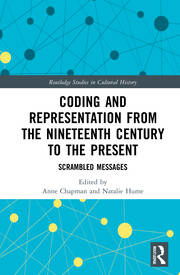1st Edition
Coding and Representation from the Nineteenth Century to the Present Scrambled Messages
An exploration of trends and cultures connected to electrical telegraphy and recent digital communications, this collection emerges from the research project Scrambled Messages: The Telegraphic Imaginary 1866–1900, which investigated cultural phenomena relating to the 1866 transatlantic telegraph. It interrogates the ways in which society, politics, literature and art are imbricated with changing communications technologies, from the mid-nineteenth century to the present. Contributors consider control, imperialism and capital, as well as utopianism and hope, grappling with the ways in which human connections (and their messages) continue to be shaped by communications infrastructures.
Introduction 1
ANNE CHAPMAN AND NATALIE HUME
1 To Be Connected: Perspectives on Autonomy and Risk from the Electric Age 7
MANU LUKSCH AND MUKUL PATEL
2 Cyborg Imperium, c. 1900 48
DUNCAN BELL
3 Universal Visual Languages in the Age of Telegraphy 71
GRACE BROCKINGTON
4 Plotting Passengers at a Metropolitan Station: Paddington in the Mid-Nineteenth Century 96
NICOLA KIRKBY
5 ‘Some Sentient Creature’. The Cable Body and the Body of Labour: Robert Dudley, William Howard Russell and the 1865 Voyage of the Great Eastern 114
KATE FLINT
6 Signal Markings in Victorian Miscellanies: Noise and Signal from the Idyll to Aestheticism 137
CAROLINE ARSCOTT AND CLARE PETTITT
7 ‘Recoding the Sea’: Uneven and Combined Capitalism in the Work of Allan Sekula (Telegraph Version) 161
GAIL DAY AND STEVE EDWARDS
8 random international 189
INTERVIEW BY ANNE CHAPMAN AND NATALIE HUME
Biography
Anne Chapman researches the interplay of cultural and social forms in the nineteenth and early twentieth century with interests in periodical culture, short fiction and the confluence of the visual and the verbal. She teaches at Glasgow Caledonian University London.
Natalie Hume is an independent art historian whose research interests include medium, material culture and the politics of visual representation. Her PhD, awarded by the Courtauld Institute of Art, investigated nineteenth-century transatlantic relations through the lens of commercial art.




